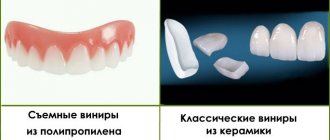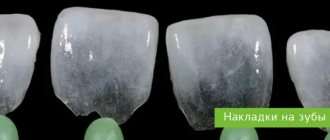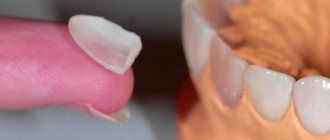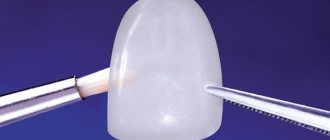Watching domestic and foreign stars, viewers have more than once noticed their instant transformation. Of course, a huge number of professionals work on the image of celebrities. But when it comes to a perfect smile, everyone can achieve such a result these days. Hollywood veneers are the best helpers in creating a flawless image. Reviews from doctors and patients indicate that onlays solve many problems of aesthetic disorders: they hide unattractive shades of enamel, cracks and crevices, interdental spaces, and even change the size and shape of teeth.
There are several types of dental onlays - there are ordinary veneers, and there is such a term as “Hollywood veneers”. Despite the fact that they have almost the same name, these are completely different microprostheses - different technologies are used for their manufacture, they differ in the method of fixation, as well as in cost and service life. Let's look at each option in more detail.
What are veneers?
Veneers are thin plates that are attached to the surface of the teeth.
They are made of ceramics and composite materials. In some specialized literature, these plates are called laminates. Are they like finishing flooring material? hide the base, giving it a more attractive look.
Veneers differ from traditional crowns because they do not completely cover the tooth, but only cover one or two of its surfaces. Most often, such “plates” are installed on the front teeth, forming the smile line.
IMPORTANT: Unlike crowns, veneers look more natural and aesthetically pleasing. With their help, you can give your teeth a more natural shape and correct some defects.
Veneers are classified according to the materials from which they are made:
Ceramic veneers. For their production, zirconium dioxide and medical porcelain are used. Plates made from this material are highly durable and do not change color over time. The thickness of such a ceramic plate is only 0.3 - 0.5 mm.
Such veneers have only one disadvantage - high cost.
Composite veneers. Nowadays this type of veneers is practically not used, as it is considered outdated. In addition, composite plates have a number of disadvantages. They are less attractive and have a short service life. Among the advantages, it should be noted the relatively low cost and fast and gentle installation.
Hollywood laminates. The newest type of veneers characterized by the smallest plate thickness. Only 0.2 mm. Hollywood laminates are made of porcelain, but unlike ceramic veneers, they have a longer service life and are easier to use.
IMPORTANT: Hollywood laminates can be used over an artificial crown.
Teeth covered with veneers are no different from real teeth. It is advisable to use such plates if teeth whitening with conventional technologies does not produce results. Installing veneers can restore teeth with defects in the shortest possible time.
Main advantages
The main advantage of veneers, as well as their undeniable advantage over metal-ceramic crowns, is considered to be high aesthetics and naturalness. Microprosthetics allows you to correct external defects of teeth or give them good shape in a short time. The photo shows convincing examples of how, after installing veneers, a smile becomes attractive.
In some cases, veneers replace crowns. If there is significant destruction or the presence of a large filling, it is necessary to resort to dental prosthetics. However, it is quite acceptable to cover adjacent units with veneers made of a similar material.
Durable ceramic veneers look highly aesthetic. They serve for a long period of time, and do not darken. They have only one drawback - quite high cost. However, the problem is quickly solved by applying for an interest-free installment plan, which is offered by some dental clinics.
The advantageous quality is that to install the plate it is not necessary to sharpen the tooth as much as for a crown. For a veneer, it is necessary to remove only a small amount of enamel on the front and incisal edges of the tooth. Thus, in the absence of contraindications, veneers are clearly preferable to classic crowns.
Restorations using light-polymer materials are also inferior to veneer plates. Over time, they begin to change their color to a darker color, which may require replacement. The period of use is much shorter. If you need to use filling material, it is almost impossible to restore the natural color. In any case, a clear border will be clearly visible.
Veneers are considered an excellent alternative to braces when the patient has a correct bite and slight curvature of the dentition. The question of the possibility and necessity of installing elements should be decided by an orthodontist.
The service life of veneers is several times longer than the duration of wearing composite elements. With proper care and use, it reaches 20 years for porcelain and 10 years for ceramic ones.
Hollywood veneers for front teeth
The term “Hollywood smile” originated in the middle of the last century.
- The history of this expression is associated with the name of the famous Marilyn Monroe. She was not lazy to show off her “flawless” teeth on the movie screens in which she took part.
- It’s surprising, but dentist Charles Pincus “corrected” the beautiful Marilyn’s smile. No, these weren’t veneers yet, but the fashion for snow-white teeth started after Monroe’s smile
- If there is demand, then there must be supply. Dentists have long solved the problem of producing materials for the formation of flawless teeth. And the company Cerinate succeeded in this, in whose laboratory a dental correction technology was developed that used lumineers
- Unlike veneers, which had also come into use by that time, lumineers (Hollywood veneers) were comparable in thickness to a contact lens and practically did not require special care
IMPORTANT: Even teeth that are perfectly white from birth fade with age. If a smile is an integral part of your image, then regular dental care is no longer enough to maintain the proper effect. Hollywood veneers are a great way to make your teeth dazzling.
Service cost
Prices for veneers vary greatly. Their cost directly depends on several factors:
- manufacturer of filling materials and the chosen method of manufacturing elements. Composite ones will cost less, and they will be installed in one visit. The costs for zirconium or ceramics are much higher, and they take longer to produce.
- To achieve an ideal result, it may be necessary to correct ten teeth that are clearly visible when smiling at the same time.
- The material of the linings significantly influences the overall cost. Thus, lumineers are considered the most expensive, and composites are the cheapest. Zirconium dioxide veneers fall into the mid-price category.
- High costs will also have to be borne by paying for the work of a specialist. It is charged for consultation, preparation for the procedure, selection of materials and application of platins. Sometimes it is necessary to use anesthesia, which is used during the removal of the upper dental layer. Some cases require additional significant expenses for the treatment of caries or diseased gums.
The dentist will be able to announce specific numbers only after conducting a dental examination, selecting the appropriate material, and also based on the number of units that fall under restoration.
Dental restoration with veneers
Elimination of defects using veneers is indicated for:
- Non-carious enamel lesions
- The appearance of discoloration of the enamel, the appearance of stains on it and discoloration
- Traumatic chips
- Crooked teeth
Veneers do not discolor during use
Plaques and stains do not form on such “plates”. In addition to their aesthetic function, veneers can provide additional protection to weakened enamel.
IMPORTANT: You can correct your bite with veneers. At the same time, the cost of such a correction will be significantly lower than the cost of braces traditionally used for this purpose. And they install much faster.
Before restoring teeth with veneers, you should consult your dentist. He will tell you whether they can be used or whether they are not suitable in your particular case. In addition, the dentist must examine the oral cavity and, if dental problems are identified, prescribe treatment. Veneers can only be installed on healthy teeth.
The production and installation of the “plates” usually takes a week. After a preliminary examination, the dentist must treat the teeth, heal possible caries and remove tartar. Then he must make impressions of the teeth, from which the veneers will be made.
If correction of teeth is required, then after taking impressions, a model of the jaw is recreated, and with its help plates are created.
At the next appointment, the dentist tries on the veneers and identifies some defects that require improvement.
The plates are installed only after they fit perfectly and satisfy the patient.
Directly installing veneers on teeth takes about three hours.
After such microprosthetics, it is necessary to limit heavy loads on the teeth and visit the dentist several times a year for correction and necessary dental care.
Indications
Indications for installing Cerec veneers are not only aesthetic, but also medical:
- yellow or gray “native” color of enamel;
- deterioration of enamel color as a consequence of depulpation;
- fluorosis changes;
- non-carious destruction of hard tissues;
- enamel erosion;
- abnormal shapes of individual fragments, large distances between them, chipped surfaces, twisted upper incisors;
- outdated fillings with a strong difference in color from their own tissues;
- demineralization of enamel after wearing braces or other orthodontic treatment.
Such a diverse list of indications makes the use of veneers very attractive, especially since there are no restrictions on the choice of color and tone.
German ceramic factory blocks are produced across the entire range from brown to snow-white, which does not in any way affect their high strength.
Veneers before and after
Before installation After installation
Before installation After installation
| Recommended: | Not recommended: |
| When there is a gap between the front teeth, to hide the gap | For gum disease and caries |
| To create a beautiful smile | For weak teeth, it is better to use crowns |
| When the color of the enamel changes, spots appear | If you have bruxism (grinding your teeth while you sleep), you cannot use overlays. |
| When filling front teeth | For teeth lacking a nerve; |
| For crooked teeth | For significant tooth defects |
| If the smile zone tooth is broken | In case of severe bite pathology |
Contraindications
Like any prosthetic procedure, the installation of Cerec veneers also has cases that are not recommended:
- increased abrasion;
- incorrect bite (in this case, the installation is carried out only after orthodontic correction of the bite);
- bad habits that provoke enamel wear, gum inflammation or trauma with tooth loss;
- gaps in the dentition in the form of the absence of several chewing units in a row (here you can also install veneers after installing a bridge, but the procedure will be unnecessary, since modern dentures can initially be made to perfectly match the color).
Veneers advantages
- Thin ceramic plates perfectly imitate the surface of a tooth. With their help, you can accurately convey its anatomical structure.
- Veneers are installed very quickly compared to other types of prosthetics. In one or two visits to the dental office.
- Ceramic plates resist temperature changes well and can withstand heavy loads.
- They do not stain from coffee and black tea.
- When installing veneers, the thickness of the tooth grinding does not exceed 0.3 mm.
- With the help of such plates you can improve your bite and teeth shape.
- They give teeth natural whiteness and shine.
- With their help, you can eliminate enamel cracks, chips and other defects.
Flaws
This technology currently has only two drawbacks: price and a small number of qualified specialists.
Not every clinic can offer the installation of Cerec veneers. This is due to the purchase of expensive equipment, manufacturing materials, software, and personnel training.
The price of the product is also made up of these same points. The procedure does not belong to the generally available price category, but still, it is not the most expensive one on the market. It is quite comparable in price to other types of prosthetics.
The lack of specialists and the high price are temporary phenomena, because training and acquisition of technology still occurs, since the demand for this type of prosthetics is very high.
Over time, every clinic will be able to offer Cerec veneers to their patients, and due to healthy competition, the price will fall.
Features of manufacturing crowns using Nobel Procera technology, and the advantages of the technique.
We will discuss here all the pros and cons of dental prosthetics under anesthesia.
At this address https://www.vash-dentist.ru/protezirovanie/nesemnyie-p/mostyi/zubov-bez-obtochki-vidyi-preimushhestva-tsenyi.html we will talk about methods of dental prosthetics without grinding.
Veneers cons
- Porcelain “onlays” are very fragile and are unable to increase the strength of teeth
- If you neglect the rules for using and caring for veneers, they may break or peel off over time.
- Sometimes, when installing veneers, significant damage to the teeth can occur. After which you will have to wear such onlays for the rest of your life or replace the tooth with an artificial one.
- Composite veneers are not very reliable and require replacement every 3-5 years.
- Aesthetically, composite veneers leave much to be desired.
Installation
The installation and production of Cerec veneers is a one-time process; you may have to sit in the dental chair for half an hour longer than when treating regular caries, but the result will be a perfect fragment.
The essence of the procedure consists of the following stages:
- First, the doctor prepares the tooth , that is, removes old fillings (which are at risk of falling out), cleans carious lesions, removes plaque and other additions unnecessary to the patient.
- An anti-reflective spray is then applied to the repaired unit , and the remaining crown and adjacent fragments are scanned using an intraoral camera.
- The scan results are transferred to a computer , where a bioengineering model of the future bone organ is created. A side photo is also taken to more accurately select the appearance of the product. At this time, the patient can rinse his mouth, participate in choosing a color and simply wait in a chair; the procedure is not long at all.
- At the end of the modeling, a device for aesthetic ceramic restoration comes into operation ; it grinds the required shape from a porcelain block strictly according to the computer model. Manufacturing takes place within 10-15 minutes.
- After production, fitting takes place , if all is well, then the outer surface is additionally polished, a layer of glaze is applied, and the mold is fired in the oven. The manufacturing process is now complete.
The last stage will be fixation, that is, gluing the veneer to the tooth. The gluing is absolutely hermetically sealed, so there is no reason to worry about the formation of repeated caries or other possible troubles.
The installation procedure is complete. The patient can go home and fully use the new tooth without any restrictions.
Dental veneers, ceramic and composite
- But, there are several methods that allow you to install plates made of composite material based on dental impressions
- When using composite veneers, the surface is first prepared, and then a layer of special material is applied to it. It is firmly fixed on the tooth and forms a single whole with it.
- Due to the elasticity of this material, it interacts reliably with the tooth. Peeling can only occur under heavy load
- When making composite veneers, a specialist can choose a shade of material that will practically not differ from the enamel of neighboring teeth.
- Ceramic porcelain veneers are made separately and bonded to the patient's teeth using a special dental compound. In modern practice, the template for making such plates is an optical impression of the patient’s jaw
- Ceramic plates are made by turning from solid blocks, by layer-by-layer application of ceramic powders or by injection molding
In any case, ceramic veneers have a longer service life than composite ones and their installation is less difficult for the patient
Today it is believed that composite veneers are more appropriate to use to eliminate enamel defects on 1-2 teeth. When it comes to three or more teeth, ceramic veneers are preferable.
Manufacturing technology
Ceramic plates are made in two ways: unpressed and pressed. In the first case, the material is applied in layers, followed by consolidation of the result (firing) in a kiln. The pressing method involves creating veneers by casting when exposed to high temperatures. The service life of such plates is much longer than that of veneers made from unpressed ceramic mass.
For ceramic veneers, teeth are first prepared, and then a 3D impression is made of them for subsequent computer modeling. The zirconium dioxide structure is machined using a milling cutter, without the direct participation of a specialist. A non-permanent laminate is placed on the prepared tooth. The veneer is further processed from the inside to roughen the surface for secure installation. Fixation is done using cement.
Composite plates are made directly in the dental office, during a doctor’s appointment. These designs are called direct or therapeutic. The orthopedist restores the surface by removing a small layer of enamel on the visible part of the tooth and gradually applying a light-polymer composite. In another case, the dentist only grinds down the tooth and makes an impression, from which a veneer is made in the laboratory.
Veneers: tips and reviews
Marina. I have had these on my two front teeth for 3 years now. When I installed it, I didn’t know anything about veneers. The dentist suggested composite ones (I understand this now), since the service life was 3-5 years. Now I try not to put any stress on these teeth. I try to eat nuts, apples and other solid foods more carefully. Otherwise, everything is the same as with normal teeth.
Alyona. I installed it 10 years ago from composite material. Very pleased. Now I've converted it to ceramics. They look very beautiful and natural. I hope they will continue to please me.
Video. Hollywood smile before and after. The whole truth about how veneers are placed. Anna Belle
Service life, warranty
On average, the service life of composite veneers is 2-5 years, and there is the possibility of their subsequent renewal by polishing. Ceramic plates have been successfully worn for 10 to 20 years, and many patients claim that they continue to use them beyond the expiration date.
Sometimes veneers are changed only because they are tired of the snow-white color, which was in fashion some time ago. Today, most men and women prefer to less clearly show others that their beautiful smile and real, not artificial, teeth are just a good result of the dentist’s work.











